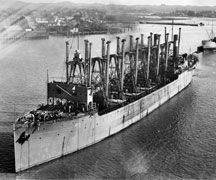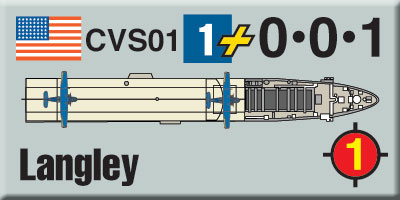| Java Sea:
The
Covered Wagon
By Mike Bennighof, Ph.D.
November 2021
 During the First World War, the Royal Navy
constructed the world's first true aircraft
carrier, HMS Argus. Converted from
an incomplete liner, she had flush deck with
no "island" structure like later
aircraft carriers. Two others followed: Eagle,
converted from an incomplete Chilean battleship,
and Hermes, built from the keel up
as an aircraft carrier. Several other ships
were converted into partial carriers, like
the light battle cruiser Furious and
the cruiser Vindictive. During the First World War, the Royal Navy
constructed the world's first true aircraft
carrier, HMS Argus. Converted from
an incomplete liner, she had flush deck with
no "island" structure like later
aircraft carriers. Two others followed: Eagle,
converted from an incomplete Chilean battleship,
and Hermes, built from the keel up
as an aircraft carrier. Several other ships
were converted into partial carriers, like
the light battle cruiser Furious and
the cruiser Vindictive.
American naval aviators saw these ships and
lusted for one of their own. They even believed
the German High Seas Fleet had converted an
armored cruiser into an aircraft carrier,
but this had actually only been a limited
conversion to create a hybrid seaplane carrier.
After the war ended, they began to agitate
for an American carrier.
With the world's most expensive war to date
just ended, Congress had little desire to
fund additional warship construction. Even
the huge 1916 program stood in danger of cancellation,
and the desire to avoid these expenses would
lead directly to the Washington Naval Conference
of 1922. Conservative admirals opposed any
aircraft carrier, while a handful of forward-thinking
staff officers pressed both openly and in
private for a carrier. Chief among the agitators
were Capt. Ernest J. King, the future Chief
of Naval Operations, and Capt. W.S. Pye, who
commanded the battle line at Pearl Harbor.
 |

Made obsolete by oil. The giant collier Jupiter, soon after completion,
1913. |
 |
|
Capt. Thomas T. Craven, the new head of Naval
Aviation, saw his chance when a colleague
mentioned that the fleet's huge colliers would
soon be retired. Starting with the Nevada class, new battleships would be powered solely
by oil, which also freed space for the radical
"all or nothing" armor scheme for
which these ships would become famous. The
U.S. Navy had launched a class of huge ships
designed to provide battleships with coal
at maximum speed, carrying a huge volume of
coal and the derricks and transport belts
to load the ships quickly.
"We proceeded to angle for the colliers Jupiter and Jason," Craven
recalled later. "Although some conservative
seniors frowned on the plan, in time and with
the Secretary of the Navy's approval, we persuaded
Congressional committees of the wisdom of
converting one ship."
Jupiter was very slow, capable of
14 knots at best, but was a relatively new
ship, having been commissioned only in 1913
and used to test electric drive. She was large
enough to support an adequate flight deck,
and her huge, high-ceilinged holds promised
an easy conversion to aircraft hangars. Plus
she required a comparatively small crew.
Craven made his play in May 1919, Congress
appropriated funding in July, and she was
taken in hand at Norfolk Naval Shipyard in
March 1920. A month later she was renamed Langley, for aviation pioneer Samuel
Pierpont Langley, and designated CV-1. Designs
were drawn up rapidly and were very simple.
"We thought she could be converted cheaply,"
wrote Cdr. Kenneth Whiting, the ship's first
commander. "That was a mistake. . . .
We thought she could be converted quickly.
That was another mistake."
Known as the "Covered Wagon" for
her boxy appearance and slow speed, and as
the "Floating Abortion" to battleship
officers, the new carrier was finally commissioned
in March 1922. She could carry up to 30 aircraft,
with both a hangar deck and a hold that could
be used to stow disassembled planes. Her collier
origins meant that she had been designed to
be proof against coal dust explosions, and
her designers kept many of the features, leaving
large openings in her hangar deck to vent
fumes from aviation fuel. She had adjustable
smoke stacks, which could be turned down during
flight operations to minimize interference.
Commissioned during the Washington Naval
Limitation talks, she was immediately put
to use testing concepts for the next generation
of American aircraft carriers. She tested
both arresting gear and catapult launches
— Whiting himself piloted the first
plane launched from her catapult. But the
large number of engineering experiments took
time away from pilot training and fleet exercises,
and the Bureau of Aeronautics (successor to
the Director of Naval Aviation's office) now
agitated for Jupiter's sister ship Jason to be converted into a carrier
as well to provide full-time training capability.
This time they lost, though they did eventually
get their hands on the ship — converted
instead into a seaplane tender, with her big
derricks used to handle aircraft instead of
coal.
Langley did not participate in a fleet
exercise until March 1925, when her aircraft
scouted for the Battle Force during maneuvers
off the coast of southern California. She
spent most of the next dozen years in the
Pacific, conducting pilot training and continuing
to work with the fleet. The Navy continued
to list her as an "experimental ship,"
and therefore not subject to treaty limitations
on aircraft carriers, despite clearly deploying
her as a front-line unit.
By 1936, that fiction was wearing thin and
new carriers had been built or ordered. Never
really suitable for work with the fleet, Langley went to Mare Island Naval Yard for conversion
to a seaplane tender. She lost the forward
third of her flight deck, and much of her
hangar space became workshops and storage.
The remaining flight deck became a work area,
and she proved very popular with her crew
in this new role — the comparatively
huge open area was very useful for working
on aircraft. It was not long enough to launch
aircraft, and the catapult had been removed
with the forward part of the deck.
 |

Langley soon after conversion,
1937. |
 |
|
Recommissioned in February 1937, she operated
from several West Coast ports and made a brief
Atlantic deployment before heading to the
Philippines in September 1939. She was at
Cavite Navy Yard when the Japanese attacked
on 8 December 1941, and immediately headed
south through the Dutch East Indies to Darwin,
Australia. After several weeks tending seaplanes
there, she was selected to transport Army
Air Force fighters to Ceylon.
The big, open deck had already made Langley a favorite for aircraft transport duties before
the war, but she could not be loaded at Darwin
and had to go to Freemantle in Western Australia
instead, where the deck was jammed with 32
P-40 aircraft, the most that could be fitted.
She then joined a convoy escorted by the cruiser Phoenix, but the Dutch Admiral Conrad
Helfrich, commander of Allied forces in Java,
ordered Langley and the transport Seawitch,
carrying 21 disassembled P-40 fighters, to
leave the convoy and head to Java.
With the island's major ports under attack,
Helfrich ordered the planes taken to Tjilatjap
on the southern coast. The planes were essential
to the defense of Java, the admiral instructed,
and the ship would have to be sacrificed if
necessary to deliver them — if Tjilatjap
had fallen to the Japanese, or if she could
not enter the port, Langley's captain
was to beach his ship and offload the fighters
onto the beach with his cranes. The seaplane
tender could fuel them there, and the pilots
would take off and fly to their airfields.
Tjilatjap had no facilities to offload aircraft;
while Langley steamed northward workers
rushed to widen city streets and build ramps. Langley, steaming separately from Seawitch,
made most of the voyage unescorted; she picked
up an anti-submarine escort of two American
destroyers in the early morning of 27 February.

This is the end.
The planes came at 0900. Fifteen Japanese
land-based bombers made two passes before
their attack. Langley desperately radioed
for fighter cover, but none was to be had
— the bulk of Java's fighter defense
sat on her deck, unable to launch. On the
third pass, the planes let loose their bombs
and scored five direct hits and three misses.
Aircraft exploded, fires broke out and the
ship began to sink. Eventually rising water
stopped her engines, and at 1332 the destroyers
began to take off her crew. The destroyer Whipple finished off the wreck with
two torpedoes and several four-inch shells.

Langley appears in Second World War at Sea: Java Sea in her seaplane guise, with a beautiful new drawing on her “long” ship piece.
You can order Java Sea right here.
Please allow an extra six weeks for delivery.
Sign up for our newsletter right here. Your info will never be sold or transferred; we'll just use it to update you on new games and new offers.
Mike Bennighof is president of Avalanche Press and holds a doctorate in history from Emory University. A Fulbright Scholar and NASA Journalist in Space finalist, he has published a great many books, games and articles on historical subjects; people are saying that some of them are actually good.
He lives in Birmingham, Alabama with his wife, three children, and his Iron Dog, Leopold.
Want to keep Daily Content free of third-party ads? You can send us some love (and cash) through this link right here.
|
